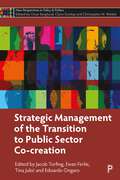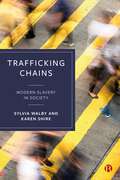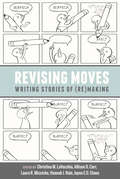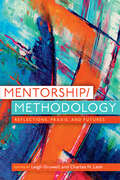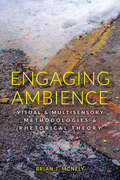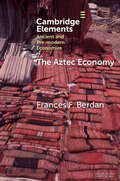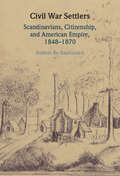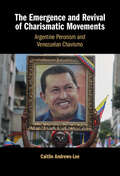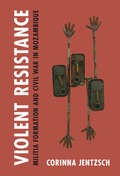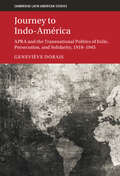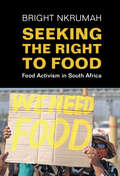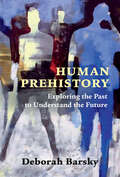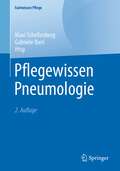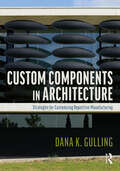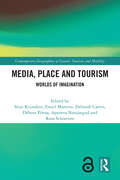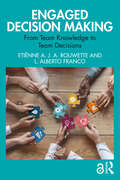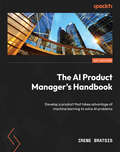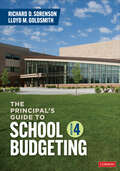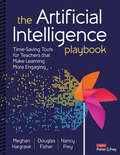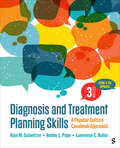- Table View
- List View
Advancements in Microbial Biotechnology for Soil Health (Microorganisms for Sustainability #50)
by Ravi Kant Bhatia Abhishek WaliaThis edited book covers the latest trends to improve soil health. It provides an easy-to-understand information to the readers. This book acts as a reference book for various agronomists and research scholars working in the field of agriculture. This edited book covers advanced technologies and practices carried out worldwide to improve soil health. In the present scenario, it is very important to save soil health and replenish it in a sustainable manner from various anthropogenic hazards. As soil is the source to almost all lives on earth and it is duty, the scientific community is developing ways to disseminate and communicate the most recent advancements to restore its health. Content of the book is designed in such a way that it provides a compressive information to the readers to restore the soil health that will ultimately help to improve the health of microbes, animals as well as plants that thrive in the soil and ultimately the quality of life of human being. This book helpsresearch scholars and teachers working in agriculture, horticulture, and environmental management by utilizing advances in microbiology and biotechnology. It is of interest to undergraduate and graduate students, teachers, researchers, environmentalists, agriculture and horticulture scientists, capacity builders, policy makers and all other stakeholders.
Strategic Management of the Transition to Public Sector Co-Creation
by Jacob Torfing, Ewan Ferlie, Tina Jukić and Edoardo OngaroAs the practices of public governance are rapidly changing, so must the theoretical frameworks for understanding the creation of efficient, effective and democratic governance solutions. First published as a special issue of Policy & Politics journal, this book explores the role of strategic management, digitalisation and generative platforms in encouraging the co-creation of innovative public value outcomes. It considers why we must transform the public sector to drive co-creation and the importance of integrating different theoretical strands when studying processes, barriers and outcomes. This book lays out important stepping-stones for the development of new research into the ongoing transition to co-creation as a mode of governance.
Trafficking Chains: Modern Slavery in Society
by Sylvia Walby Karen ShireAvailable open access digitally under CC-BY-NC-ND license. This book offers a theory of trafficking and modern slavery with implications for policy. Despite economic development, modern slavery persists all around the world. The issue is not only one of crime but the regulation of the economy, better welfare, and social protections. Going beyond polarized debates on the sex trade, an original empirical analysis shows the importance of profit-taking. Although individual experience matters, the root causes lie in intersecting regimes of inequality of gender regimes, capitalism, and the legacies of colonialism. This book shows the importance of coercion and the societal complexities that perpetuate modern slavery.
Revising Moves: Writing Stories of (Re)Making
by Christina M. LaVecchia Allison D. Carr Laura R. Micciche Hannah J. Rule Jayne E. O. StoneRevision sometimes seems more metaphor than real, having been variously described as a stage, an act of goal setting, a method of correction, a process of discovery, a form of resistance. Revising Moves makes a significant contribution to writing theory by collecting stories of revision that honor revision’s vitality and immerse readers in rooms, life circumstances, and scenes where revision comes to life. In these narrative-driven essays written by a wide range of writing professionals, Revising Moves describes revision as a messy, generative, and often collaborative act. These meditations reveal how revision is both a micro practice tracked by textual change and a macro phenomenon rooted in family life, institutional culture, identity commitments, and political and social upheaval. Contributors depict revision as a holistic undertaking and a radically contextualized, distributed practice that showcases its relationality to everything else. Authors share their revision processes when creating scholarly works, institutional and self-promoting documents, and creative projects. Through narrative the volume opens a window to what is often unseen in a finished text: months or years of work, life events that disrupt or alter writing plans, multiple draft changes, questions about writerly identity and positionality, layers of (sometimes contradictory) feedback, and much more.
Mentorship/Methodology: Reflections, Praxis, and Futures
by Leigh Gruwell Charles N. LeshMentorship/Methodology brings together emerging and established scholars to consider the relationship between mentoring practices and research methodologies in writing studies and related fields. Each essay in this edited collection produces a new intellectual space from which to theorize the dynamics of combining mentoring and research in institutions and communities of higher education. The contributors consider how methodology informs mentorship, how mentorship activates methodology, and how to locate the future of the field in these moments of intersection. Mentorship, through the research and relationships it nourishes, creates the future of writing studies—or, conversely, reproduces the past. At the juncture where this happens, the contributors inquire, Where have current arrangements of mentorship/methodology taken writing studies? Where do these points of intersection exist in performance and practice, in theory, in research? What images of the field do they produce? How can scholars better articulate and write about these moments or spaces in which mentorship and methodology collide in productive disciplinary work? By making the “slash” more visible, Mentorship/Methodology provides significant opportunities to support and cultivate diverse ways of knowing and being in rhetoric and composition, both locally and globally. The volume will appeal to students and scholars of rhetoric, composition, and technical and professional communication, as well as readers interested in conversations about mentorship and methodology.
Engaging Ambience: Visual and Multisensory Methodologies and Rhetorical Theory
by Brian McNelyEngaging Ambience is an in-depth exploration of contemporary rhetorical theory, drawing from rich traditions of visual and sensory research. It is the first book to develop comprehensive empirical approaches to ambient rhetoric and the first to offer systematic approaches to visual research in studies of rhetoric and writing. These approaches address the complexities of everyday life and offer practical advice for understanding the factors that shape individuals and communities, how they understand one another, and the kind of world they envision. By articulating theoretically sound methodologies and methods for the empirical study of rhetoric conceived as originary, immanent, and enveloping, Brian McNely contributes a methodological perspective that furthers new materialist theories of rhetoric. McNely demonstrates how scholars’ emergent theories of rhetoric call for new methodologies that can extend their reach, and in the process, he proposes a new conception of visual rhetoric. Engaging Ambience delineates methodologies and methods that help researchers in rhetoric and writing studies discover the ambient environments that condition and support everyday communication in all its forms. Engaging Ambiencedetails and demonstrates visual and multisensory methodologies and methods for exploring the wondrous complexity of everyday communication. It will appeal to scholars and students of rhetorical theory, visual and multisensory rhetorics, and composition and writing studies.
The Aztec Economy (Elements in Ancient and Pre-modern Economies)
by Frances F. BerdanThe Aztec Economy provides a synthesis and updated examination of the Aztec economy (1325–1521 AD). It is organized around seven components that recur with other Elements in this series: historic and geographic background, domestic economy, institutional economy, specialization, forms of distribution and commercialization, economic development, and future directions. The Aztec world was complex, hierarchical, and multifaceted, and was in a constant state of demographic growth, recoveries from natural disasters, political alignments and realignments, and aggressive military engagements. The economy was likewise complex and dynamic, and characterized by intensive agriculture, exploitation of non-agricultural resources, utilitarian and luxury manufacturing, wide-scale specialization, merchants, markets, commodity monies, and tribute systems.
Civil War Settlers: Scandinavians, Citizenship, and American Empire, 1848–1870
by Anders Bo RasmussenCivil War Settlers is the first comprehensive analysis of Scandinavian Americans and their participation in the US Civil War. Based on thousands of sources in multiple languages, that have to date been inaccessible to most US historians, Anders Bo Rasmussen brings the untold story of Scandinavian American immigrants to life by focusing on their lived community experience and positioning it within the larger context of western settler colonialism. Associating American citizenship with liberty and equality, Scandinavian immigrants openly opposed slavery and were among the most enthusiastic foreign-born supporters of the early Republican Party. However, the malleable concept of citizenship was used by immigrants to resist draft service, and support a white man's republic through territorial expansion on American Indian land and into the Caribbean. Consequently, Scandinavian immigrants after emancipation proved to be reactionary Republicans, not abolitionists. This unique approach to the Civil War sheds new light on how whiteness and access to territory formed an integral part of American immigration history.
The Emergence and Revival of Charismatic Movements: Argentine Peronism and Venezuelan Chavismo
by Caitlin Andrews-LeePolitical movements founded by charismatic leaders are often considered ephemeral. Existing literature argues that because they rest on unmediated, emotional attachments between leaders and followers, these movements either fade quickly after their leaders disappear or transform into routinized parties. Yet, charismatic movements around the world have proven surprisingly resilient and have retained their personalistic core. Focusing on Argentine Peronism and Venezuelan Chavismo, this book investigates the nature and trajectory of charismatic movements from the perspectives of both leaders and followers. Using interviews, focus groups, and survey experiments, Caitlin Andrews-Lee reveals that charismatic movements can emerge, survive, and become politically revived by sustaining - not discarding - their personalistic character. Followers' charismatic attachments to the movement founder can develop into an enduring, deeply affective political identity that successors can reactivate under certain conditions by portraying themselves as symbolic reincarnations of the founder. Consequently, charismatic movements can have lasting, deleterious effects on democracy.
Violent Resistance: Militia Formation and Civil War in Mozambique (Cambridge Studies in Contentious Politics)
by Corinna JentzschWhy do communities form militias to defend themselves against violence during civil war? Using original interviews with former combatants and civilians and archival material from extensive fieldwork in Mozambique, Corinna Jentzsch's Violent Resistance explains the timing, location and process through which communities form militias. Jentzsch shows that local military stalemates characterized by ongoing violence allow civilians to form militias that fight alongside the government against rebels. Militias spread only to communities in which elites are relatively unified, preventing elites from coopting militias for private gains. Crucially, militias that build on preexisting social conventions are able to resonate with the people and empower them to regain agency over their lives. Jentzsch's innovative study brings conceptual clarity to the militia phenomenon and helps us understand how wartime civilian agency, violent resistance, and the rise of third actors beyond governments and rebels affect the dynamics of civil war, on the African continent and beyond.
Journey to Indo-América: APRA and the Transnational Politics of Exile, Persecution, and Solidarity, 1918–1945 (Cambridge Latin American Studies #123)
by Geneviève DoraisThe American Popular Revolutionary Alliance (APRA) was a Peruvian political party that played an important role in the development of the Latin American left during the first half of the 1900s. In Journey to Indo-América, GenevieÌve Dorais examines how and why the anti-imperialist project of APRA took root outside of Peru as well as how APRA's struggle for political survival in Peru shaped its transnational consciousness. Dorais convincingly argues that APRA's history can only be understood properly within this transnational framework, and through the collective efforts of transnational organization rather than through an exclusive emphasis on political figures like APRA leader, Víctor Raúl Haya de la Torre. Tracing circuits of exile and solidarity through Latin America, the United States, and Europe, Dorais seeks to deepen our appreciation of APRA's ideological production through an exploration of the political context in which its project of hemispheric unity emerged.
Seeking the Right to Food: Food Activism in South Africa
by Bright NkrumahDespite a constitutional right to food, a comprehensive social security structure, being a net exporter of agricultural products and maintaining a rising GDP, freedom from hunger remains a pipedream for millions of South Africans. With a constant surge in food prices, the availability of sustenance is often seriously threatened for all of South Africa's population. While the underprivileged majority residing in townships often demonstrate their discontent for poor service delivery on the streets, they rarely channel this strategy into taming food inflation. This study seeks to understand this irony and examine ways in which this trend could be reversed. Proposing a compelling argument for food activism, Bright Nkrumah suggests ways of mobilising disempowered groups to reclaim this inherent right. Presented alongside historical and contemporary case studies to illustrate the dynamics of collective action and food security in South Africa, he draws from legal, social and political theory to make the case for 'activism' as a force for alleviating food insecurity.
Human Prehistory: Exploring the Past to Understand the Future
by Deborah BarskyThis book provides a concise overview of human prehistory. It shows how an understanding of the distant past offers new perspectives on present-day challenges facing our species - and how we can build a sustainable future for all life on planet Earth. Deborah Barsky tells a fascinating story of the long-term evolution of human culture and provides up-to-date examples from the archaeological record to illustrate the different phases of human history. Barsky also presents a refreshing and original analysis about issues plaguing modern globalized society, such as racism, institutionalized religion, the digital revolution, human migrations, terrorism, and war. Written in an accessible and engaging style, Human Prehistory is aimed at an introductory-level audience. Students will acquire a comprehensive understanding of the interdisciplinary, scientific study of human prehistory, as well as the theoretical interpretations of human evolutionary processes that are used in contemporary archaeological practice. Definitions, tables, and illustrations accompany the text.
Pflegewissen Pneumologie (Fachwissen Pflege)
by Mavi Schellenberg Gabriele IberlPneumologie im Wandel – Pflege auf dem neusten Stand!Dieses Buch bietet Pflegenden auf pneumologischen Stationen und Einrichtungen spezielles Fachwissen für die kompetente und umfassende Versorgung ihrer Patienten.Die Durchführung von allgemeinen und speziellen Pflegemaßnahmen bei der Betreuung von Menschen mit akuten und chronischen Atemwegserkrankungen erfordert besondere fachliche und psychosoziale Fähigkeiten. Besonders in der Pandemie wurde dies nochmal deutlich. Lernen Sie anhand konkreter Fallbeispiele, wie Sie theoretische Grundlagen in der Praxis effektiv umsetzen können. Das interdisziplinäre Autorenteam macht deutlich, dass die pflegerischen Aufgaben bei der Behandlung einen wesentlichen Teil einnehmen und das Outcome der Patienten positiv beeinflussen.
Custom Components in Architecture: Strategies for Customizing Repetitive Manufacturing
by Dana GullingThis book offers architects strategies in the design and manufacturing of custom, repetitively manufactured building components.A total of 36 case studies from around the globe demonstrate the diversity of CRM in architecture and are contributed by architecture firms, including Diller Scofidio + Renfro, Kengo Kuma & Associates, Abin Design Studio, Behnisch Architekten, Belzberg Architects, and many more. The book is organized by manufacturing process and covers the use of various types of glass, clay, plastic, metal, wood, plaster, and concrete. Each process is described with diagrams and text and expanded with one or more examples of customized building components. Projects included are of buildings of various types, sizes, and clients, and many deviate from the typical manufacturing process as they include a secondary process (e.g. casting glass, then slumping it), special tooling modifications (e.g. dams used to subdivide a mold), post-production processes, or other notable manufacturing features. Each case study includes a project overview, behind‐the‐scenes images of the component manufacturing, and original diagrams that illustrate how those components were customized.Custom Components in Architecture will be essential reading for any architect interested in building design details and keeping up-to-speed on material advances. Upper-level students of digital architecture, fabrication, and building technology will also find this a useful tool.
Media, Place and Tourism: Worlds of Imagination (ISSN)
by Reijnders, Edited by Stijn Emiel Martens Deborah Castro Débora PóvoaAccessible and interdisciplinary in nature, this volume highlights the connections between media, tourism and place, bringing together the diverse perspectives, approaches and actors involved in critical issues relating to media tourism worldwide.This book explores new avenues, adopting a global and transnational perspective and placing emphasis on the exploration, analysis and comparison of cases from around the world. Encompassing chapters from a plethora of experts, the volume discusses processes and relationships of power involved in the development and experience of media tourism. This book seeks to broaden the horizons of both the reader and existing academic research into media tourism by including research into, among other topics, Bollywood and Nollywood films, Brazilian telenovelas and South Korean K-pop culture. Illustrated with tables and figures throughout, the volume presents insights from a variety of strands of cutting-edge and empirically rich research, which are collated, compared and contrasted to demonstrate the connections between media, tourism and place around the world.International in scope, this book is an ideal companion for academics and scholars within a wide array of disciplines, such as media studies, tourism studies, fan studies, cultural geography and sociology, as well as those with an interest in media tourism more specifically.The Open Access version of this book, available at www.taylorfrancis.com, has been made available under a Creative Commons Attribution-Non Commercial-No Derivatives (CC- BY- NC- ND) 4.0 license.
Engaged Decision Making: From Team Knowledge to Team Decisions
by Etiënne A. Rouwette L. Alberto FrancoIn the knowledge economy, teams play a central role in decisions made within and across organisations. The reason why teams with diverse compositions are often used is arguably their ability to develop solutions that none of their members could have produced alone. Systems design, strategy and policy development, risk management, and innovation are just a few of the areas that call for team decisions. Unfortunately, a considerable number of behavioural research studies show that teamwork is fraught with difficulties. Teams often underestimate their fallibility, struggle with conflict, or are unable to share and integrate critical information effectively. Indeed, the evidence shows that two out of three teams do not achieve their goals and half of organisational decisions – many of which are team decisions – fail.In this book, the authors draw from research in psychology, decision and systems sciences – as well as their own research and consulting work that spans more than 20 years – to show how designed interventions can enable team decision making to become rigorous, transparent, and defensible. They cover theory and practice regarding the design, delivery, and evaluation of interventions to support team decision making in situations of varied complexity. Written as an applied resource for researchers and advanced students in particular, this book offers a guide to proven interventions that enhance the process of making team decisions and increase the chances of superior team results.The Open Access version of this book, available at www.taylorfrancis.com, has been made available under a Creative Commons Attribution-Non Commercial-No Derivatives (CC-BY-NC-ND) 4.0 license.
The AI Product Manager's Handbook: Develop a product that takes advantage of machine learning to solve AI problems
by Irene BratsisMaster the skills required to become an AI product manager and drive the successful development and deployment of AI products to deliver value to your organization.Purchase of the print or Kindle book includes a free PDF eBook.Key FeaturesBuild products that leverage AI for the common good and commercial successTake macro data and use it to show your customers you're a source of truthBest practices and common pitfalls that impact companies while developing AI productBook DescriptionProduct managers working with artificial intelligence will be able to put their knowledge to work with this practical guide to applied AI. This book covers everything you need to know to drive product development and growth in the AI industry. From understanding AI and machine learning to developing and launching AI products, it provides the strategies, techniques, and tools you need to succeed.The first part of the book focuses on establishing a foundation of the concepts most relevant to maintaining AI pipelines. The next part focuses on building an AI-native product, and the final part guides you in integrating AI into existing products.You'll learn about the types of AI, how to integrate AI into a product or business, and the infrastructure to support the exhaustive and ambitious endeavor of creating AI products or integrating AI into existing products. You'll gain practical knowledge of managing AI product development processes, evaluating and optimizing AI models, and navigating complex ethical and legal considerations associated with AI products. With the help of real-world examples and case studies, you'll stay ahead of the curve in the rapidly evolving field of AI and ML.By the end of this book, you'll have understood how to navigate the world of AI from a product perspective.What you will learnBuild AI products for the future using minimal resourcesIdentify opportunities where AI can be leveraged to meet business needsCollaborate with cross-functional teams to develop and deploy AI productsAnalyze the benefits and costs of developing products using ML and DLExplore the role of ethics and responsibility in dealing with sensitive dataUnderstand performance and efficacy across verticalsWho this book is forThis book is for product managers and other professionals interested in incorporating AI into their products. Foundational knowledge of AI is expected. If you understand the importance of AI as the rising fourth industrial revolution, this book will help you surf the tidal wave of digital transformation and change across industries.
Perchance to DREAM: A Legal and Political History of the DREAM Act and DACA (Citizenship and Migration in the Americas)
by Michael A. OlivasThe first comprehensive history of the DREAM Act and Deferred Action for Childhood Arrivals (DACA)In 1982, the Supreme Court of the United States ruled in Plyler v. Doe that undocumented children had the right to attend public schools without charge or impediment, regardless of their immigration status. The ruling raised a question: what if undocumented students, after graduating from the public school system, wanted to attend college? Perchance to DREAM is the first comprehensive history of the DREAM Act, which made its initial congressional appearance in 2001, and Deferred Action for Childhood Arrivals (DACA), the discretionary program established by President Obama in 2012 out of Congressional failure to enact comprehensive immigration reform. Michael A. Olivas relates the history of the DREAM Act and DACA over the course of two decades.With the Trump Administration challenging the legality of DACA and pursuing its elimination in 2017, the fate of DACA is uncertain. Perchance to DREAM follows the political participation of DREAMers, who have been taken hostage as pawns in a cruel game as the White House continues to advocate anti-immigrant policies. Perchance to DREAM brings to light the many twists and turns that the legislation has taken, suggests why it has not gained the required traction, and offers hopeful pathways that could turn this darkness to dawn.
The Principal′s Guide to School Budgeting
by Richard D. Sorenson Lloyd M. GoldsmithAlign your school budget with your vision for student achievement Since 2006, The Principal′s Guide to School Budgeting has been a best-seller, supporting thousands of principals in navigating the complex process of school budgeting. This fourth edition hones in on the message that a school budget should be a reflection of the school’s vision for student growth, an open culture, and a positive school climate. This edition offers new information on how national and state reform and political practices affect school allocations and emphasizes the need for appropriate budget visioning, planning, analysis, and needs assessment. Covering the budgeting process, effective budgeting practices, accounting and auditing procedures, and building the school budget within a collaborative decision-making context, this comprehensive guide includes: In-chapter vignettes and discussion questions Case study applications and experiential exercises A budget development project New discussion of technology′s impact on budgetary practices, phishing scams, and fundraising The Principal′s Guide to School Budgeting is an essential resource for practicing and aspiring school administrators who want to master their accounting and auditing procedures. By effectively managing the school budgeting process, principals can contribute to improved student achievement and strengthen connections with the school community.
The Principal′s Guide to School Budgeting
by Richard D. Sorenson Lloyd M. GoldsmithAlign your school budget with your vision for student achievement Since 2006, The Principal′s Guide to School Budgeting has been a best-seller, supporting thousands of principals in navigating the complex process of school budgeting. This fourth edition hones in on the message that a school budget should be a reflection of the school’s vision for student growth, an open culture, and a positive school climate. This edition offers new information on how national and state reform and political practices affect school allocations and emphasizes the need for appropriate budget visioning, planning, analysis, and needs assessment. Covering the budgeting process, effective budgeting practices, accounting and auditing procedures, and building the school budget within a collaborative decision-making context, this comprehensive guide includes: In-chapter vignettes and discussion questions Case study applications and experiential exercises A budget development project New discussion of technology′s impact on budgetary practices, phishing scams, and fundraising The Principal′s Guide to School Budgeting is an essential resource for practicing and aspiring school administrators who want to master their accounting and auditing procedures. By effectively managing the school budgeting process, principals can contribute to improved student achievement and strengthen connections with the school community.
The Artificial Intelligence Playbook: Time-Saving Tools for Teachers that Make Learning More Engaging
by Meghan Hargrave Douglas Fisher Nancy FreyTime Saving AI Tools that Make Learning More Engaging Busy educators need tools that support their planning and provide them with more time with students. While Artificial Intelligence (AI) has emerged as a promising solution, it can only help if we’re willing to learn how to use it in ways that improve upon what we already do well. The Artificial Intelligence Playbook: Time Saving Tools that Make Learning More Engaging is here to empower teachers to explore AI’s potential and discover practical ways to implement it to enhance their planning and instruction. Two chapters and 6 "Educator Functions" guide teachers step-by-step through how to purposely use AI to: Compose Writing Prompts and Avoid Plagiarism Manage Content Foster Student Engagement Meet Students’ Instructional Needs Assess Student Learning Continue Lifelong Learning Though AI has the potential to reduce workload for educators, it will never replace teachers. Your connection with students is irreplaceable—and greatly impacts their learning. Consider AI a valuable tool that provides you with more time to build and sustain those vital relationships with students and that can assist them in learning at the very same time.
Diagnosis and Treatment Planning Skills: A Popular Culture Casebook Approach
by Alan M. Schwitzer Amber L. Pope Lawrence C. RubinThe Third Edition of Alan M. Schwitzer, Amber L. Pope, and Lawrence C. Rubin′s Diagnosis and Treatment Planning Skills: A Popular Culture Casebook Approach thoroughly covers essential clinical thinking skills in professional counseling through classic and contemporary popular culture case examples. Fully revised for use with the DSM-5-TR, the text begins with discussion of diagnosis, case conceptualization, and current treatment planning practices, covering the interplay of individual clinical tools and their application in contemporary practice. Twenty DSM-5-TR updated case illustrations follow, representing a diverse range of individual differences and intersecting identities. Students will engage with each case illustration in a start-to-finish application of clinical tools.
The Artificial Intelligence Playbook: Time-Saving Tools for Teachers that Make Learning More Engaging
by Meghan Hargrave Douglas Fisher Nancy FreyTime Saving AI Tools that Make Learning More Engaging Busy educators need tools that support their planning and provide them with more time with students. While Artificial Intelligence (AI) has emerged as a promising solution, it can only help if we’re willing to learn how to use it in ways that improve upon what we already do well. The Artificial Intelligence Playbook: Time Saving Tools that Make Learning More Engaging is here to empower teachers to explore AI’s potential and discover practical ways to implement it to enhance their planning and instruction. Two chapters and 6 "Educator Functions" guide teachers step-by-step through how to purposely use AI to: Compose Writing Prompts and Avoid Plagiarism Manage Content Foster Student Engagement Meet Students’ Instructional Needs Assess Student Learning Continue Lifelong Learning Though AI has the potential to reduce workload for educators, it will never replace teachers. Your connection with students is irreplaceable—and greatly impacts their learning. Consider AI a valuable tool that provides you with more time to build and sustain those vital relationships with students and that can assist them in learning at the very same time.
Diagnosis and Treatment Planning Skills: A Popular Culture Casebook Approach
by Alan M. Schwitzer Amber L. Pope Lawrence C. RubinThe Third Edition of Alan M. Schwitzer, Amber L. Pope, and Lawrence C. Rubin′s Diagnosis and Treatment Planning Skills: A Popular Culture Casebook Approach thoroughly covers essential clinical thinking skills in professional counseling through classic and contemporary popular culture case examples. Fully revised for use with the DSM-5-TR, the text begins with discussion of diagnosis, case conceptualization, and current treatment planning practices, covering the interplay of individual clinical tools and their application in contemporary practice. Twenty DSM-5-TR updated case illustrations follow, representing a diverse range of individual differences and intersecting identities. Students will engage with each case illustration in a start-to-finish application of clinical tools.

